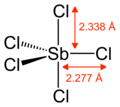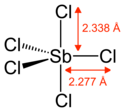Pentachlorek antymonu
| |||||||||||||||||||||||||||||||||||||||||||||||||||
 | |||||||||||||||||||||||||||||||||||||||||||||||||||
| |||||||||||||||||||||||||||||||||||||||||||||||||||
| Ogólne informacje | |||||||||||||||||||||||||||||||||||||||||||||||||||
| Wzór sumaryczny | SbCl5 | ||||||||||||||||||||||||||||||||||||||||||||||||||
|---|---|---|---|---|---|---|---|---|---|---|---|---|---|---|---|---|---|---|---|---|---|---|---|---|---|---|---|---|---|---|---|---|---|---|---|---|---|---|---|---|---|---|---|---|---|---|---|---|---|---|---|
| Masa molowa | 299,01–299,03[a] g/mol | ||||||||||||||||||||||||||||||||||||||||||||||||||
| Wygląd | ciemnobrązowa ciecz[1] | ||||||||||||||||||||||||||||||||||||||||||||||||||
| Identyfikacja | |||||||||||||||||||||||||||||||||||||||||||||||||||
| Numer CAS | 7647-18-9 | ||||||||||||||||||||||||||||||||||||||||||||||||||
| PubChem | 24294 | ||||||||||||||||||||||||||||||||||||||||||||||||||
| |||||||||||||||||||||||||||||||||||||||||||||||||||
| |||||||||||||||||||||||||||||||||||||||||||||||||||
| |||||||||||||||||||||||||||||||||||||||||||||||||||
| |||||||||||||||||||||||||||||||||||||||||||||||||||
| |||||||||||||||||||||||||||||||||||||||||||||||||||
| Podobne związki | |||||||||||||||||||||||||||||||||||||||||||||||||||
| Inne aniony | SbF5, SbBr5, SbI5 | ||||||||||||||||||||||||||||||||||||||||||||||||||
| Inne kationy | SbCl3 | ||||||||||||||||||||||||||||||||||||||||||||||||||
| Jeżeli nie podano inaczej, dane dotyczą stanu standardowego (25 °C, 1000 hPa) | |||||||||||||||||||||||||||||||||||||||||||||||||||
Pentachlorek antymonu, SbCl5 – nieorganiczny związek chemiczny, sól kwasu solnego i antymonu. W wodzie ulega hydrolizie na kwas antymonowy i kwas solny:
- SbCl5 + 4H2O → H3SbO4 + 5HCl
Przy ogrzewaniu rozkłada się w temperaturze około 172 °C (445 K).
Uwagi
Przypisy
- ↑ a b c d e f Antimony(V) chloride (nr 451673) – karta charakterystyki produktu Sigma-Aldrich (Merck KGaA) na obszar Polski. [dostęp 2011-06-22]. (przeczytaj, jeśli nie wyświetla się prawidłowa wersja karty charakterystyki)
- ↑ a b Pentachlorek antymonu (ang.) w wykazie klasyfikacji i oznakowania Europejskiej Agencji Chemikaliów. [dostęp 2015-04-07].
- ↑ Pentachlorek antymonu (nr 451673) (ang.) – karta charakterystyki produktu Sigma-Aldrich (Merck KGaA) na obszar Stanów Zjednoczonych. [dostęp 2011-06-22]. (przeczytaj, jeśli nie wyświetla się prawidłowa wersja karty charakterystyki)
Media użyte na tej stronie
Globally Harmonized System of Classification and Labelling of Chemicals (GHS) pictogram for corrosive substances
Symbol of pollutants to the environment, according to the directive 67/548/EWG of 'European Chemicals Bureau (European Chemicals Agency).
The "fire diamond" as defined by NFPA 704. It is a blank template, so as to facilitate populating it using CSS.
Autor: LHcheM, Licencja: CC BY-SA 3.0
A picture of a sample of antimony pentachloride (for chromatography) in an ampoule.
Structural formula of the antimony pentachloride molecule, SbCl5, with arsenic-equatorial chlorine bond of lengths of 2.277 Å and arsenic-axial chlorine bond of lengths of of 2.338 Å.
Structural information (determined by gas-phase electron diffraction) from CRC Handbook, 91st edition, page 9–28.The hazard symbol for corrosive substances according to directive 67/548/EWG by the European Chemicals Bureau, now known as the Consumer Products Safety and Quality (CPS&Q) Unit.
Globally Harmonized System of Classification and Labelling of Chemicals (GHS) pictogram for environmentally hazardous substances










